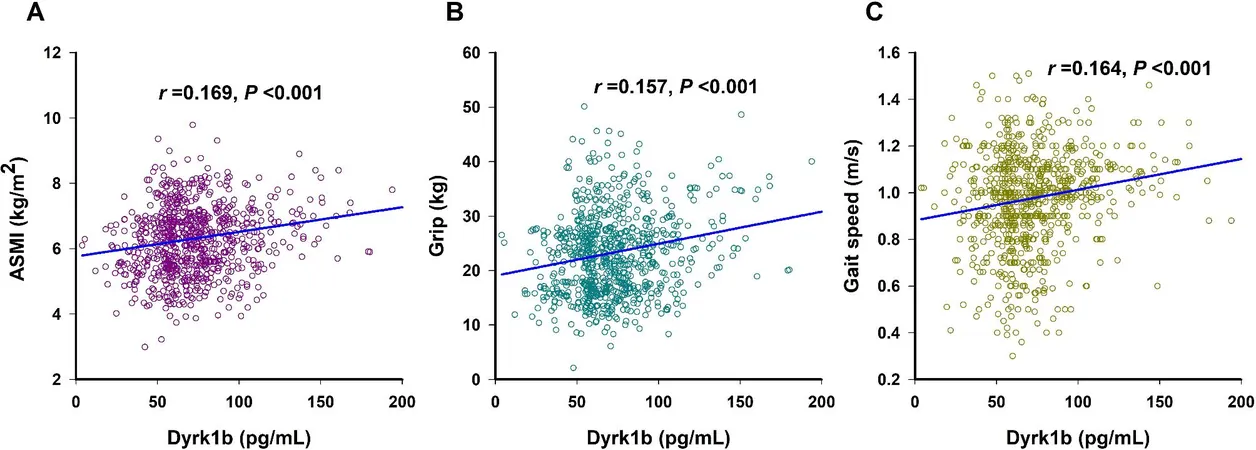
Unlocking the Mystery: Dyrk1b as a Game-Changer in Sarcopenia Detection for Older Adults
2025-04-25
Author: Mei
Understanding Sarcopenia: A Growing Concern for Seniors
As people age, the gradual decline in muscle mass and function, known as sarcopenia, poses a significant health threat. This age-related condition affects up to 18.6% of community-dwelling seniors in China alone, leading to increased risks of falls, fractures, and a diminished quality of life.
Introducing Dyrk1b: A Potential Biomarker Hero
Enter Dyrk1b (Dual-specificity tyrosine-regulated kinase 1b), a crucial player in muscle differentiation by influencing transcription, cell cycle progression, and cell survival. Despite its significant role, the link between Dyrk1b levels and sarcopenia has been a mystery—until now!
A Study of 939 Seniors: Is Dyrk1b the Key?
In a groundbreaking study involving 939 seniors (median age of 76), researchers measured serum Dyrk1b through a highly accurate enzyme-linked immunosorbent assay. Muscle mass (measured via appendicular skeletal muscle mass index or ASMI), grip strength, and gait speed were utilized to assess sarcopenia.
Results That Could Change Lives!
The findings were astonishing: seniors with sarcopenia had lower serum Dyrk1b levels—67.37 pg/mL compared to 70.40 pg/mL for non-sarcopenic individuals. The study identified a critical cutoff level of 44.73 pg/mL for Dyrk1b, heralding potential for early sarcopenia detection, boasting a sensitivity of 94.8%!
Could Dyrk1b Be the Future Face of Sarcopenia Screening?
With Dyrk1b levels correlated positively with muscle mass, grip strength, and gait speed, the evidence suggests that monitoring Dyrk1b could be a vital strategy for identifying at-risk seniors. This correlation persists even when factoring in age and diabetes, opening doors for personalized healthcare strategies.
The Bigger Picture: Implications Beyond Muscle Health
Dyrk1b’s impact extends beyond sarcopenia; it links muscle metabolism with insulin sensitivity and may play a role in various age-related diseases. As researchers dive deeper, understanding Dyrk1b could unveil new opportunities to mitigate multiple health risks associated with aging.
Looking Ahead: What’s Next for Dyrk1b Research?
Though this study offers promising insights, further research across diverse populations is essential to confirm Dyrk1b's role as a reliable biomarker for sarcopenia. Only time will tell if this kinase is the missing puzzle piece in elderly health management.



 Brasil (PT)
Brasil (PT)
 Canada (EN)
Canada (EN)
 Chile (ES)
Chile (ES)
 Česko (CS)
Česko (CS)
 대한민국 (KO)
대한민국 (KO)
 España (ES)
España (ES)
 France (FR)
France (FR)
 Hong Kong (EN)
Hong Kong (EN)
 Italia (IT)
Italia (IT)
 日本 (JA)
日本 (JA)
 Magyarország (HU)
Magyarország (HU)
 Norge (NO)
Norge (NO)
 Polska (PL)
Polska (PL)
 Schweiz (DE)
Schweiz (DE)
 Singapore (EN)
Singapore (EN)
 Sverige (SV)
Sverige (SV)
 Suomi (FI)
Suomi (FI)
 Türkiye (TR)
Türkiye (TR)
 الإمارات العربية المتحدة (AR)
الإمارات العربية المتحدة (AR)